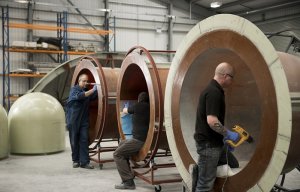New TenCate prepreg technologies at CAMX 2017
Composites
3D moulding of TenCate Liba to be shown at DSEi
TenCate Advanced Armour is to introduce a highly sophisticated method of 3D moulding for the patented TenCate Liba armour system at DSEi (Defence & Security Equipment International) in London in September. TenCate says the system will allow the replacement of existing key components of armoured vehicles, such as hatches, doors and bonnets, all traditionally made from steel, with all-composite solutions. Â Engineers of Ten

11th August 2011
Innovation in Textiles
|
London

TenCate Advanced Armour is to introduce a highly sophisticated method of 3D moulding for the patented TenCate Liba armour system at DSEi (Defence & Security Equipment International) in London in September. TenCate says the system will allow the replacement of existing key components of armoured vehicles, such as hatches, doors and bonnets, all traditionally made from steel, with all-composite solutions.
Engineers of TenCate Advanced Armour have recently completed the design and testing phases of the project and a completed solution is now being field tested. The head of R&D, Dr. Paul Bourke, emphasises the thorough and continuous testing and research, as well as the close cooperation with the vehicle manufacturer, as important for the success of the project.
Bourke explains: "The challenges of the 3D moulding project have been many, the most significant being to provide the rigidity of the steel by placing the fibres accurately, and securing that there are no ballistic weak points in the design by constantly seeking to achieve the correct weave architecture and to avoid cuts".
The key technologies in the solution are said to be 3D TenCate Liba ceramics and a no-cut aramid backing. According to TenCate, a lot of mechanical design considerations had to be made, for example structural analysis, inserts design, shaping, integration, testing and environmental properties.
Excellent properties
TenCate Liba is said to have excellent properties in terms of flexibility and multi-hit capability, and the company says the system was thus the obvious choice for the project. In addition, the TenCate Liba system approach is said to allow a flexible and cost-effective production process.
"This evolution in armour technology allows vehicle manufacturers to reduce the overall weight of the vehicle significantly, while actually improving the level of protection. The reduced weight and increase in protection are important steps to reduce life cycle costs and improve the survivability of the vehicle and its passengers," a TenCate statement said.
"Traditionally, composite armour solutions have been add-on armour panels and spall liners. Those work with the existing steel or aluminium armour of the vehicle.
"The long-term perspectives for this new 3D moulding technique is that we will be able to replace several heavy steel components from vehicles with lighter and stronger all-composite solutions - thus getting both lighter and better protected vehicles," Dr Bourke said.

Business intelligence for the fibre, textiles and apparel industries: technologies, innovations, markets, investments, trade policy, sourcing, strategy...
Find out more













